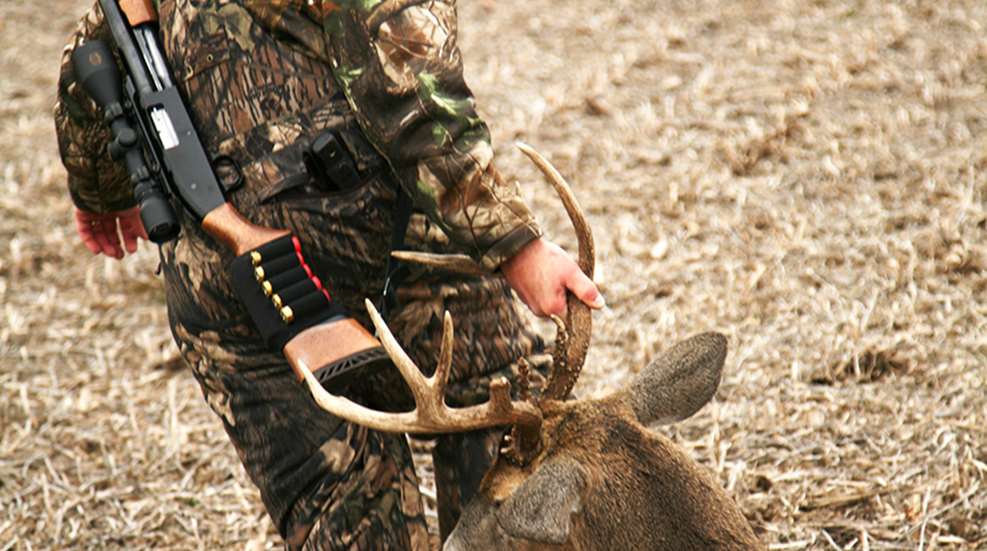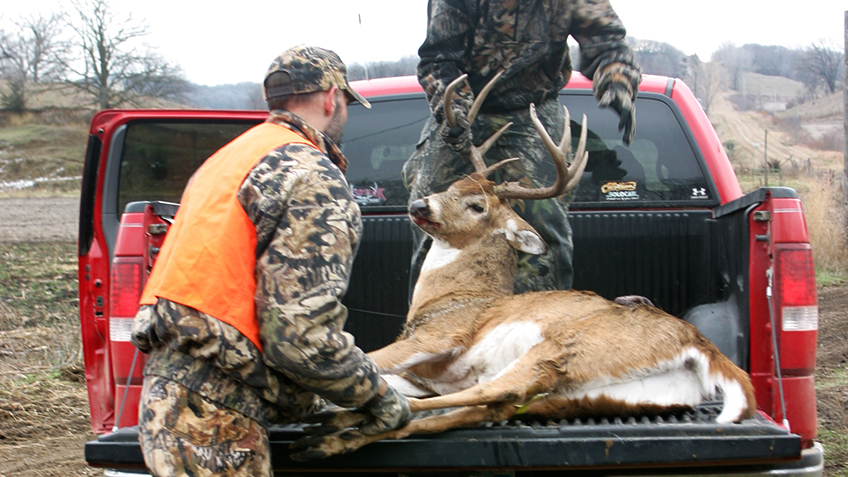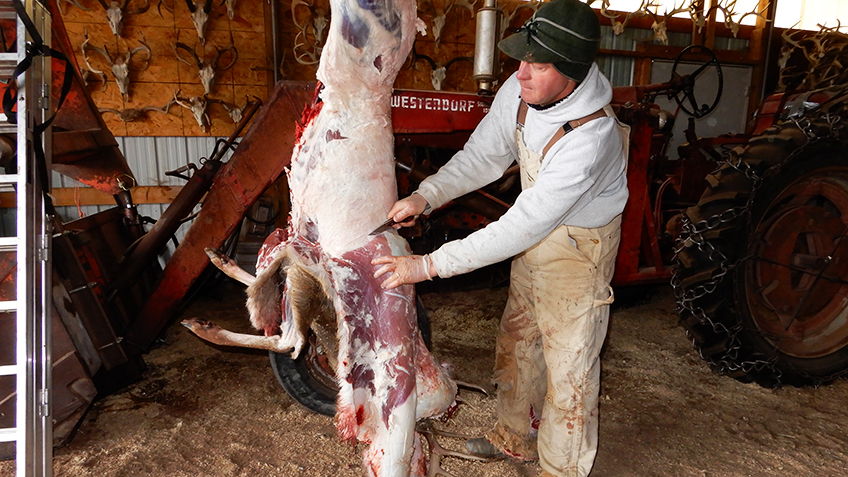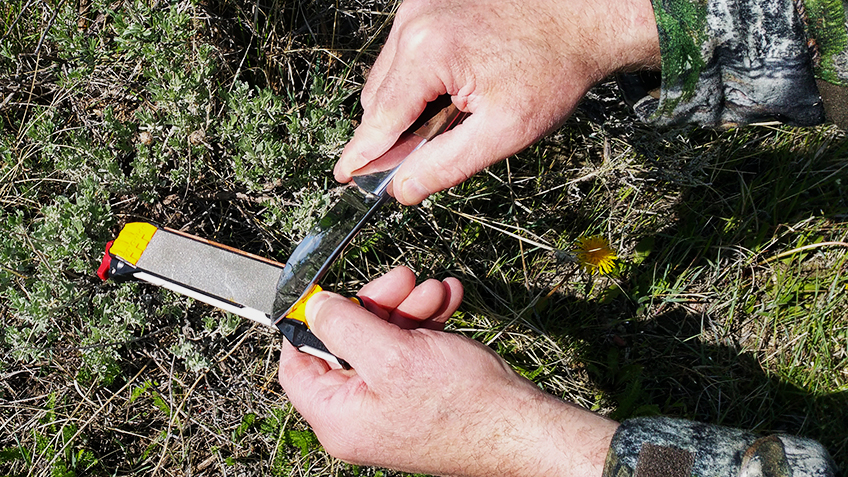
In this day of instant information at our fingertips, I was aghast at the sight before me. I had pulled into the alley of my buddy’s garage to load some hunting gear. Across the alley, hanging at the neighbor’s house was an unskinned doe. The sight of it hanging there didn’t shock me, but its haggard looks did. It was an overly warm fall, and it was clear the doe had hung there for more than a night. A simple online search would have suggested this wasn’t the road to fine dining.
The road to the perfect backstrap dinner begins well before the hanging of game at camp or at home. Nevertheless, missteps like these lay the groundwork for wrinkled noses and scraps being shuffled under the dinner table to an eager canine secretly tasked with food disposal duties.
To take a living, breathing game animal and transform it to the purest source of tasty protein takes a dedicated plan that starts long before the hunt begins. Consider these measures and you might discover a world of taste you’ve been missing in Mother Nature’s well-stocked grocery aisle.
The Gear
While you clean your firearm, attach broadheads and dust off optical elements, add “meat recovery” to your to-do list. No doubt you have a hunting knife packed, but think of every possible scenario and line up the proper gear to retrieve the meat from a buck or bull. If you’re lucky and hunting Uncle Frank’s farm, you may be able to drive to a deer and load it into your truck. If you’re 5 miles into the backcountry, you’ll need to be prepared to take out the entire, legal amount of meat on your back unless you have access to pack animals.
A sturdy length of rope comes in handy to hoist a deer out of a ravine with human or vehicle assistance. Several feet of paracord is also invaluable when hunting solo when there’s no extra hand to hold up a leg. A comfortable, well-made backpack that will easily bear 100-pound loads has merit for deer or elk, even if you only have to pack quarters from a woodlot to the road due to muddy conditions. And if the terrain allows, research game cart options, but keep in mind mountain terrain isn’t always wheel-hospitable. In addition, regulations within some wilderness areas prohibit “mechanical transport.” That includes wheeled carts. However, in some conditions, namely in snow or on flat terrain, a specialized sled can circumvent back pain.
Along with your knife and a supply of latex gloves, take along a sharpener. You may be able to do an entire deer without a blade touchup, but the thick skin of an elk dulls a blade quickly. Dull blades slow the job and invite accidents.

For insect-infested areas or lengthy wait times between pack loads, pack along game bags. Cotton, canvas and even new synthetic options handle all temperatures and degrees of ruggedness. Another lightweight addition is plastic garbage bags to use as a liner outside game bags to avoid blood spillage in your pack or to keep blood from soaking through to your clothing. Only use a bag briefly as the plastic prohibits proper meat cooling. (Additionally, plastic garbage bags should not be used to store meat directly as they may contain harmful chemicals.) Still, plastic bags definitely save on cleanup time after transportation. They also serve as a wrap for messy skull plates or full heads, again protecting you from surprise body-fluid leakage. A tarp on which to lay skinned quarters or an entire carcass also should be considered for camp, and for vehicles. Freshly skinned meat has a sticky texture. Every pine needle and loose oak leaf will stick to it, and so will dirt.
A small folding saw is handy, too, especially for removing the skull plate. If you dig European mounts you should be able to remove all other body parts with a sharp knife and cartilage knowledge. Flex any joints and slice into the recesses to separate tissue.
To get that knowledge and brush up on field-dressing, you have permission to visit the Internet. My first gutting job occurred while I was by myself, in the dark and holding a flashlight in my mouth while looking at photos in a book. Online videos make it easier.
For elk, it pays to study the gutless method of meat removal to save time. It’s fairly straightforward. Skin a quarter and either debone it or remove it in its entirety. Peel away the back hide and slice along the backbone to unfasten the beefy backstraps. After that, move around the neck and shoulders to fillet off extra scraps. Don’t skip the ending where you cut through the ribs to remove the inside loins that actually trump backstraps for flavor.
For any other big-game species with mandatory gut removal, focus on the finer points of removing the anus, bowel and a plump bladder. If you goof up on any of these and spill the contents it could taint a future dinner. For any “oops” moment, wash away any goop with clean water and repeat before processing.
The Shot
With prep and online schooling complete, it’s time for the hunt—but before you pull that trigger think, Mmmm. Make a bad shot with your firearm or even a broadhead, and it can lead to undesirable facial expressions at the table later.
Resist the urge to shoot animals in the neck or head to “save meat.” The risk is simply too high for wounding game. It’s your duty to cleanly put down any game. A shot to either region means you’re aiming at a target 4 inches square or less. That’s tiny and especially unethical when utilizing archery tackle. There’s also the option to take a “Texas heart shot” right up a deer’s bum. Don’t. Bullet expansion and its devastating path can spread feces and burst the bladder. This spreads bacteria throughout edible portions of your dinner, particularly near the inside loins.
The road to the perfect backstrap dinner begins well before the hanging of game ... .
Instead, aim for the traditional vital zone that expands the killing zone, lungs and heart, to the size of a basketball. Yes, there could be some meat loss due to bullet expansion, but it’s better to lose a burger or two as opposed to an entire winter’s supply of meat. It’s rare for any animal to escape a double-lung tap to the boiler room.
If the double-lung doesn’t present itself don’t overlook the angling-away shot. If you get it right you could pierce the liver in addition to the heart or lungs. All bloodletting is good for a quick ending. Unfortunately, trigonometry could force you to punch a projectile through the paunch. This opens up gut fluids that should be avoided at all costs. Work cautiously around any oozing gut material to avoid fouling meat.
Even a great shot will result in some meat loss. A razor-sharp broadhead will create a hemorrhagic mess at the point of entry and exit. A modern expanding bullet may appear to only leave a finger-diameter entrance wound, but the exit could be as big as your fist and leave a trail of destruction between. Fortuitously, with an aiming point just behind the front shoulder you’ll simply lose some rib meat, but there’s potential for buck fever to move the shot forward into the shoulder for more loss of dining pleasure. Inspect the damage carefully and carve away any mutilated excess. The tainting won’t be as noticeable as gut matter, but there’s no need to chance a bad meal over a missing pancake-sized cutlet.
Recovery
Throughout the entire process of field-dressing and recovery you need to keep one goal: clean meat. Take extra care to position your animal with its head uphill so gut contents roll downhill, away from the carcass. Your next decision is to leave the hide intact or remove it. In early-season and backcountry situations the answer is simple: remove it. This speeds up the process of cooling meat and reduces weight significantly for the pack out. If the pack is long and your backpacking crew is limited, debone the meat. Removing bones also cools meat quicker and, of course, reduces the weight. Meat processers make meat cuts an art, but for speed you can simply slice lengthways down each leg and fillet around the bone. Leave chunks in large portions for easy handling and drop them into your game bags for cooling, to protect them from insects and to avoid contamination from the surrounding environment.
For backcountry deer, follow a similar approach and remove any unneeded weight. When finished you will be looking at 75 pounds of deboned meat from the average buck, and 45 pounds from a doe. A bull elk could easily produce more than 250 pounds, and even a big cow can result in more than 100 pounds of deboned meat.
For late-season hunts and those hunts where a vehicle plays a major recovery role, consider leaving the hide intact until you get back home or back to base camp. The hide can play an important role for short periods during recovery by protecting venison against insects, dirt, mud, leaves and other Mother Nature nastiness.
Then, during an open-air ride, the hide collects dust and flinging mud, not exposed meat. And the hide can guard against foreign taints in the back of the truck such as spilled gas, oil or even farm chemicals. If you suspect unclean conditions or need to remove the hide, get out that tarp and wrap the carcass to safeguard your prize. Even in warm temperatures, leaving the hide on or wrapping the carcass with a tarp should not affect the quality of the meat for a couple of extra hours.
Age Equals Great Taste
According to the National Center for Home Food Preservation, cool the deboned meat or carcass to a temperature between 30-40 degrees. Next, consider if your meat will include prime cuts like backstrap steaks or end up in a burger state, including sausage. Roasts and steaks benefit from aging as naturally occurring enzymes help tenderize the meat and minimize wild game flavor, but burger realizes little benefit.
The Center recommends that “aging the carcass should be conducted at 40° F or less for no more than 2 to 3 days. Never age at room temperature.”
There is some debate on how many days to age venison at the 40-degree mark. Some of my friends extend the process to a week or more. Venison information from the Clemson University Cooperative Extension Service in South Carolina verifies this, suggesting a seven- to 14-day window for optimum benefits.

Check the forecast to see whether you can age outdoors or if you need to find an old refrigerator to use. If you’ve been super-careful with meat handling until now, a few days of proper aging only helps send red meat to the skillet in its best form.
My September backcountry archery elk hunts typically include 60-degree days and long absences from electricity. I pack three large coolers with ice in case of success. Last year on a Montana bow hunt, I killed a bull and it took two days to pack it out solo. I had to add another day for camp removal and then a day of driving. Throughout the entire time the deboned meat sat in optimum, ice-induced temperatures and my first inside loin was to die for!
If you take your venison to a processor you’ll likely be asked whether you want to add tallow. Beef or pork tallow tames taste, but more importantly it creates a better-grilling burger and is more efficient for frying. I recommend it.
Dinner Time
Speaking of the end game, if you’ve stuck to the plan, your freezer will brim with white packages. It’s time to share your hunting memories with family and friends.
I don’t endorse lying, but for a few stubborn individuals in your clan it might be advisable to just avoid describing the contents until dinner is over. Fortunately, the younger generation has a partiality toward sustainability, renewability and all-natural. Explain what’s on the table with these descriptions and you may have a winning, wild game entrée.
For our family, it’s been primarily venison or nothing. Deer, elk or pronghorn headline the dining choices, but even so, my wife and I always try to incorporate the fare in a family-friendly way. It’s easy to open a cookbook and skim the beef section for great ideas. Substitute venison for beef and voilà. Incorporate venison into any recipes that use ground meat as the main ingredient. Venison burger blends with traditional choices such as lasagna, chili and stroganoff … and who doesn’t love taco night? Summer nights equal backyard grilling of venison burgers, and on special occasions it is backstrap steaks paired with an affordable red wine (Jack Daniel’s for me).
“Beef. It’s what’s for dinner,” may ring true in many homes, but do venison right and the Beef Checkoff folks could be in for a challenge from Mother Nature’s pantry.

Stay Sharp
From start to finish you’ll rely on a sharp knife throughout the hunt. One stay-sharp option is the Havalon Piranta with its replaceable, surgical-sharp blade. It will handle all field-dressing and is ideal for caping, too. MSRP: $44.99; havalon.com.

I keep a Worksharp Guided Field Sharpener in my pack for touchups while skinning deer or elk with fixed blades. The lightweight unit includes angled bevels to start your process right. After a run-through on the diamond plates, use ceramic rods and a leather strop (included) to hone your edge to finish skinning and close out with your own close shave to look good leaving the woods. MSRP: $29.95; worksharptools.com.



































